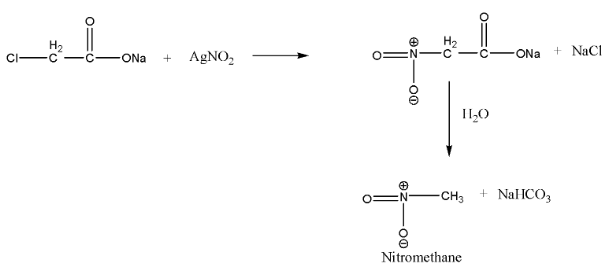
How is nitromethane prepared from
(i) $\alpha - $chloro sodium acetate
(ii) $\alpha - $nitro isobutylene?
Answer
147.6k+ views
Hint: Nitroalkanes can be obtained by treating alkyl halides with silver nitrate in alcoholic solution. Hydrolysis of $\alpha - $nitro alkene can produce nitromethane.
Complete step by step solution:
When $\alpha-$ chloro sodium acetate is treated with silver nitrate, the chlorine gets replaced by the nitro group and $\alpha - $nitro sodium acetate is formed, which undergoes hydrolysis to give nitro methane and sodium bicarbonate as a by-product.
This reaction is a nucleophilic substitution reaction. Since silver nitrite is predominantly covalent, only nitrogen pairs are available for bond formation. Hence, on adding $AgN{O_2}$, the attack of $NO_2^- $ takes place mainly through nitrogen and a nitroalkane is obtained as the major product.

$\alpha - $nitro isobutylene undergoes hydrolysis in an acidic medium to give nitromethane and acetone.

Note: When $\alpha - $ chloro sodium acetate is treated with silver nitrate, some alkyl nitrate is also formed ($20-30\% $) in the reaction along with nitroalkane. This is because$NO_2^-$ ion is an ambident nucleophile and can attack the alkyl halide through nitrogen as well as through oxygen. If $\alpha -$ chloro sodium acetate is treated with $NaN{O_2}$ or $KN{O_2}$ in place of $AgN{O_2}$, the main product will be alkyl nitrite. Nitroalkenes do not undergo hydrolysis in the basic medium to form nitromethane.
Complete step by step solution:
When $\alpha-$ chloro sodium acetate is treated with silver nitrate, the chlorine gets replaced by the nitro group and $\alpha - $nitro sodium acetate is formed, which undergoes hydrolysis to give nitro methane and sodium bicarbonate as a by-product.
This reaction is a nucleophilic substitution reaction. Since silver nitrite is predominantly covalent, only nitrogen pairs are available for bond formation. Hence, on adding $AgN{O_2}$, the attack of $NO_2^- $ takes place mainly through nitrogen and a nitroalkane is obtained as the major product.

$\alpha - $nitro isobutylene undergoes hydrolysis in an acidic medium to give nitromethane and acetone.

Note: When $\alpha - $ chloro sodium acetate is treated with silver nitrate, some alkyl nitrate is also formed ($20-30\% $) in the reaction along with nitroalkane. This is because$NO_2^-$ ion is an ambident nucleophile and can attack the alkyl halide through nitrogen as well as through oxygen. If $\alpha -$ chloro sodium acetate is treated with $NaN{O_2}$ or $KN{O_2}$ in place of $AgN{O_2}$, the main product will be alkyl nitrite. Nitroalkenes do not undergo hydrolysis in the basic medium to form nitromethane.
Recently Updated Pages
Complex Numbers - Concept of Rotation, Rotation Number, and Rotation Theorem for JEE

Entropy of Different Process - Important Concepts and Tips for JEE

Current Loop as Magnetic Dipole Important Concepts for JEE

Birch Reduction and Lindlar Catalyst Important Concepts and Tips for JEE

Introduction to Dimensions - Important Concepts and Tips for JEE

Difference Between Crystalline and Amorphous Solid

Trending doubts
JEE Main 2025 Session 2: Application Form (Out), Exam Dates (Released), Eligibility, & More

JEE Main Exam Marking Scheme: Detailed Breakdown of Marks and Negative Marking

JEE Main 2025: Derivation of Equation of Trajectory in Physics

Electric Field Due to Uniformly Charged Ring for JEE Main 2025 - Formula and Derivation

JEE Main Participating Colleges 2024 - A Complete List of Top Colleges

Degree of Dissociation and Its Formula With Solved Example for JEE

Other Pages
JEE Advanced Marks vs Ranks 2025: Understanding Category-wise Qualifying Marks and Previous Year Cut-offs

JEE Advanced 2025: Dates, Registration, Syllabus, Eligibility Criteria and More

JEE Advanced Weightage 2025 Chapter-Wise for Physics, Maths and Chemistry

Hydrocarbons Class 11 Notes: CBSE Chemistry Chapter 9

NCERT Solutions for Class 11 Chemistry In Hindi Chapter 1 Some Basic Concepts of Chemistry

Learn About Angle Of Deviation In Prism: JEE Main Physics 2025




